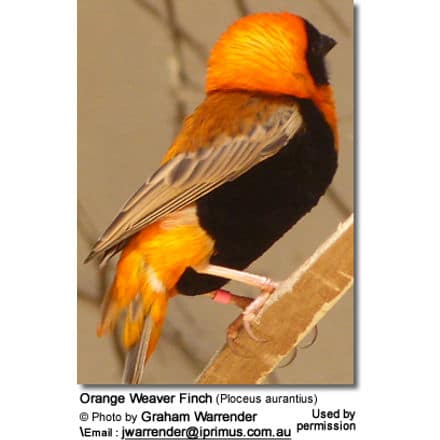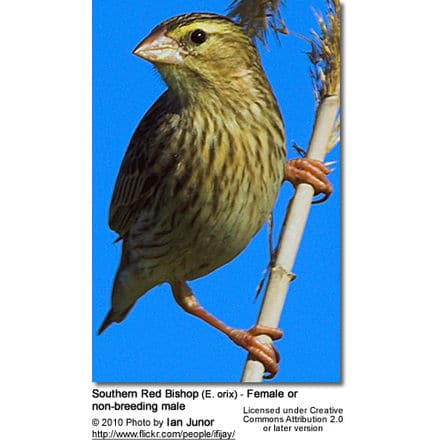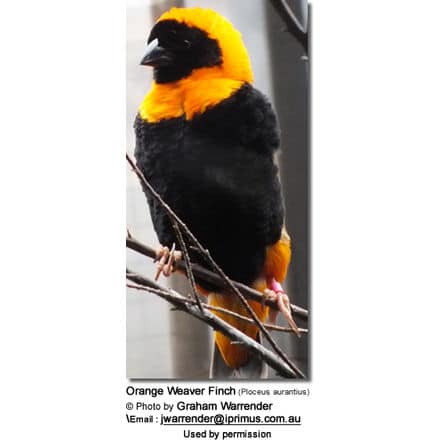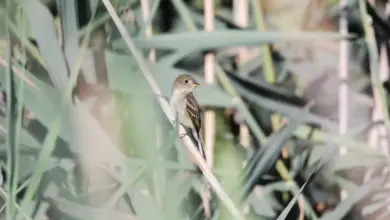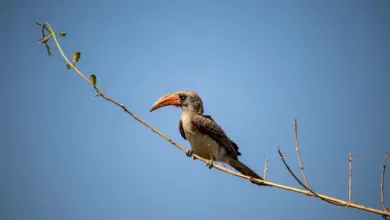Southern Red Bishops or Red Bishops or Grenadiers
The Southern Red Bishops, Grenadier, or Red Bishop Weavers (Euplectes orix) are African finches that are best known for the males’ habit of weaving complex dome nests, as well as their entertaining displays to attract potential females.
North of the Equator, these weavers are replaced by the related Northern Red Bishop (also known as Orange Bishop). The latter was formerly considered a subspecies of the Red Bishop.
In the wild, these social birds nest in colonies, and they generally roost and forage in flocks – often together with other members of the weaver family.
Distribution / Habitat
Red Bishop Weavers or Grenadiers occur from southern and western Angola east through the eastern and southern parts of the Democratic Republic of Congo, southern Uganda, Rwanda, Burundi, south-west Kenya south to Tanzania, Malawi, Zambia, Zimbabwe, and central and southern Mozambique, west to eastern Botswana, South Africa, Swaziland, the lowlands of Lesotho north to Namibia.
They are generally avoiding the Namib and Kalahari Deserts.
They are found in wetland and grassland areas, along waterways, and on agricultural lands (such as sugar cane fields).
Non-breeding Grenadiers may wander into drier grassland and savanna habitats.
Subspecies and Ranges:
Not all authorities agree with the below taxonomy and lump them all together with the nominate form, treating this race as monotypic (one species).
- Grenadier Bishop, Grenadier Weaver, Little Bishop, Southern Red Bishop (Euplectes orix orix – Linnaeus, 1758) – Nominate Form
- Ukamba Red Bishop (Euplectes orix nigrifrons – Böhm, 1884)
- Range: Found along the eastern shore of Lake Tanganyika in Tanzania
- Zambezi Red Bishop (Euplectes orix sundevalli – Bonaparte, 1850)
- Range: Found in the south-eastern parts of the Eastern Cape in South Africa
- Red Bishop (Euplectes orix turgidus – Clancey, 1958)
- Range: Found in western parts of the province of Western Cape situated in the southwest of South Africa.
Description
Size
Southern Red Bishops are Sparrow-sized birds that measure between 3.9 – 5.9 inches (10 – 15 cm) in length (including the tail) and weigh between 0.8 – 0.95 oz (25 – 27 g).
Males are generally larger than females.
Plumage Details / Adults
They come in two color phases depending upon the season.
Breeding Males:
The plumage is a combination of bright red / orange and black plumage.
The head is red, except for the black forehead, face, and throat.
The upper plumage is red, except for the brown wings and tail.
The upper chest and under tail feathers (coverts) are red.
The lower chest and abdomen are black.
Non-breeding (Eclipse) Males and Females:
Resemble plain House Sparrows, with a streaky brown plumage that is paler below. There is a pale yellow stripe above each eye that is generally more pronounced in the male.
Other Physical Details
- Females and juveniles have thick, conical, horn-colored bills. Males have a dark tinge to their bills.
Mutations
A yellow mutation in Grenadier has occurred in captivity, in which the yellow feathers replace the red or orange feathers of the male. Those few mutation birds were not able to produce young and were believed to be sterile.
Gender ID
- Breeding males can easily be identified by their colorful plumage, as described above. Females tend to be a little smaller, but this is not a reliable indicator. Male fledglings have larger, thicker legs and feet compared to females. Females and immature birds resemble the non-breeding males but often have lighter-colored beaks and legs. Males often retain a dark tint to their beaks, even when in eclipse plumage.
Juvenile Description
Juveniles Grenadiers resemble the non-breeding males and females.
Rarely, young males have been reported to molt into their adult plumage at the early age of one year, but in most cases, they are 18 months to two years old.
Similar Species
- Easily confused with breeding males of the Northern Red Bishop – but they can be identified by their red throats, and the black patch extending further back on the crown and below the bill. Females, juveniles, and non-breeding males are identical to those of the Northern Red Bishop.
- The Black-winged Red Bishop or Crimson-crowned Weaver is black below the bill and red above the bill.
- The Orange Weaver / Bishop is black above the bill and orange below the bill.
Diet / Feeding
Southern Red Bishops feed on a variety of seeds, grains, and plant food. Those raising young increase the percentage of live food in their diet to meet their growing chicks’ demand for protein.
Captive Diet
A good quality finch seed mix that either includes or should have been added to Canary seeds, Millets, and Yellow and Red Panicum. Soaked and sprouted seeds provide additional nutrients.
A variety of live foods, such as mealworms, crickets, small grasshoppers, small cockroaches, termites, and moths, should be readily available during the nesting period. Non-breeding birds are usually less interested in live food.
Some fruits (e.g. apple, sweet corn) and some green leafy vegetables can be offered. Preferences will vary and experimenting with different produce will allow you to identify the items they like, and which ones they don’t. Some also like soft foods, while others ignore them. This will also depend on what they are used to / have been raised on.
Breeding / Nesting
Southern Red Bishops nest in colonies with most nesting occurring in late spring to late summer.
The male will work on several dome-shaped nests each one with a side entrance, weaving them out of grasses and other plant material.
The nest is usually suspended between reeds, forked dry brushes, or 2 to 4 strong branches of low trees or shrubs.
The male strips ribbons of foliage or makes use of grass-type blades growing in their environment to weave the nest with.
As he is building the nests, he also performs display flights and fluffs his feathers to attract females to his nests. Once he sees a preference for one or more of the nests, he will concentrate on those and abandon the others.
The females will settle down in their chosen nest and personalize it by lining it with soft grasses, plant material, and feathers.
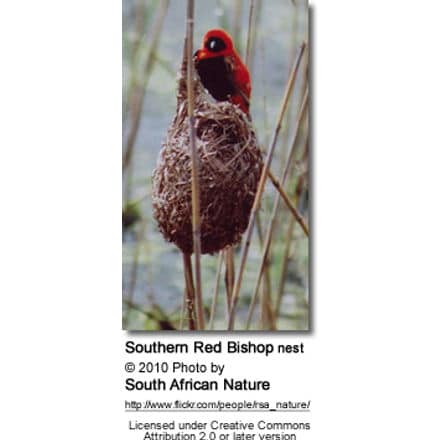
The male will mate with several females.
The average clutch consists of 1 – 4 aqua-blue eggs (mostly 2 – 3), which are incubated for about 14 days. Even though the female does most of the brooding, the male will assist. They may produce another clutch, or even two, in favorable conditions.
The young fledge (leave the nest) when they are 18 – 21 days old and they are independent in another 3 weeks.
Aviculture
Southern Red Bishops fare best in large, planted aviaries as opposed to cages. The flight should contain dense, leafy shrubs, tall growing grasses, as well as potted or miniature bamboo – all of which are suitable nesting materials for the males to work with.
The females will look for a soft material to line the nests with, such as cotton wool, soft grasses, feathers down, and mosses.
One male can service several females. Some suggest 3 to 4 females per male, but others report far better breeding results with 2 – 3 females per male.
Considering that the male assists the female in brooding the eggs and raising the young, it makes sense to keep down the number of females he has to help. This will give the young a better chance of making it to fledging.
Fortunately, provided sufficient food is available and disturbances are kept at a minimum, Southern Red Bishops make excellent parents.
Since these finches are generally not aggressive, they can be kept together with other finches of similar size and even smaller birds, including grass finches or waxbills.
However, they generally dislike Golden Song Sparrows and Green Singing Finches, and it is also best to avoid related finch species, such as Orange Weavers / Bishops and Northern Red Bishops, as they will readily hybridize.
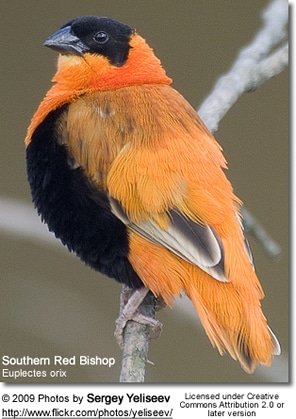
Some report that keeping two breeding males in a flight promotes competition between them thus stimulating breeding.
However, males should not be added to the aviary during the breeding season – particularly not when females are sitting on eggs or raising young as this may interrupt the breeding process, and may even result in eggs and chicks ending up dead on the floor, or one of the males being killed.
Occasionally females pull the bottoms out of other nests. If this happens, it’s important to quickly repair those nests to prevent eggs or chicks from falling to their death.
Non-breeding males are usually very peaceful; however, as soon as they molt into their breeding plumage, they will aggressively guard and protect their nests and surrounding areas.
Provided sufficient space is available for all, this usually doesn’t cause problems. The less space available for each pair, the higher the risk of injuries (and potentially death) amongst the aviary occupants. The other aviary occupants usually learn to avoid displaying males.
During the breeding season, it is recommended to remove non-breeding birds, thus reducing the risk of them being attacked by over-protective males. This will allow pairs to raise their young with less interruption and conflict.
Nest inspections are generally tolerated, although some hens are less tolerant than others.
Once the young have hatched, the parents will need an unlimited supply of live food to feed chicks with – especially for the first week.
At this time, mealworms, maggots, crickets, moths, small spiders, and other insects are sought after to feed the chicks. If not enough live food is available, or if they are disturbed too often, they may abandon their chicks.
Calls / Vocalizations / Sounds
Grenadiers have various twittering and nasal contact calls. Males have a buzzing song.
https://www.xeno-canto.org/embed.php?XC=100532&simple=1

Alternate (Global) Names
Afrikaans: Rooivink …Chinese: ????, ???? …Catalan: Teixidor vermell …Czech: Prádelník cervený, snova? kaferský …Danish: Oryxvæver … Dutch: Grenadierwever … Finnish: Punapiispa …French: Euplecte ignicolore, Grand Orix, Grenadier Ignicolore, Tisserin de feu …German: Oryx Wida, Oryxweber …Italian: Vescovo rosso …Japanese: minamikinranchou, ookinranchou …Kwangali: Gomugeha …Lithuanian: Raudonasis vyskup?lis … Norwegian: Oransjevever, Rødbisp …Polish: Wiklacz ognisty …Portuguese: Bispo de testa preta, Cardeal-tecelão-vermelho …Russian: ??????? ???????? ??????, ???????? ????????? ????, ???????? ???? …Slovak: Pletiarka ohnivá, tkácik plavokrídly …Shona: Chikenya …Spanish: Obispo / Tejedor Rojo …Swedish: Eldvävare …Swahili: Kweche Mwekundu …Tswana: Mohubê …Xhosa: Intakomlilo …Zulu: iBomvana
Life Cycle
Southern Red Bishops have a life expectancy of 12 or more years.
The males reach reproductive maturity when they are about 2 years old (although some rare males at the early age of one year). Males molt into adult plumage at the same time as they reach reproductive maturity.
Females are able to breed when they are about one year old.

Weaver Information and Species Listing … Weaver Species Photo Gallery


